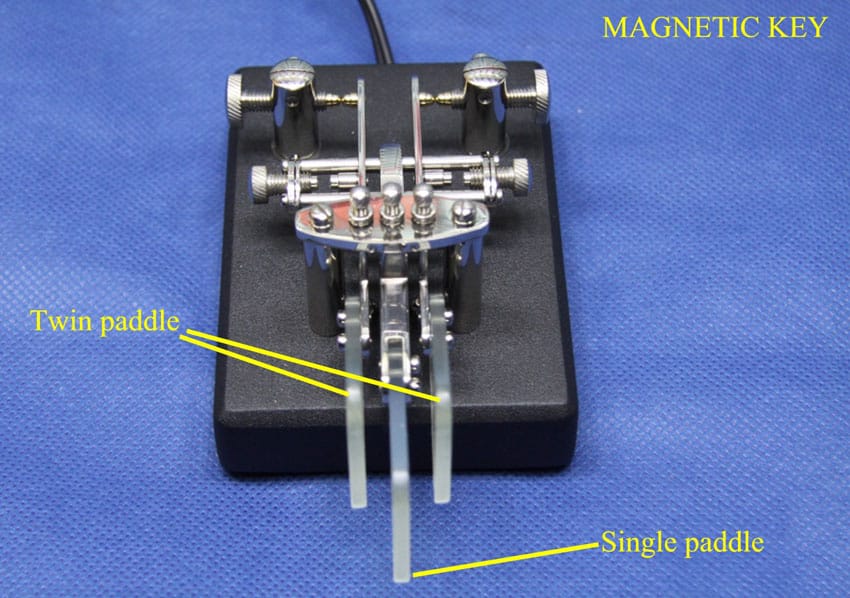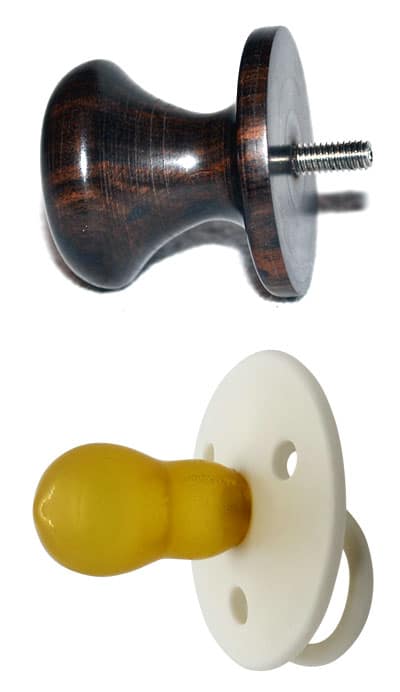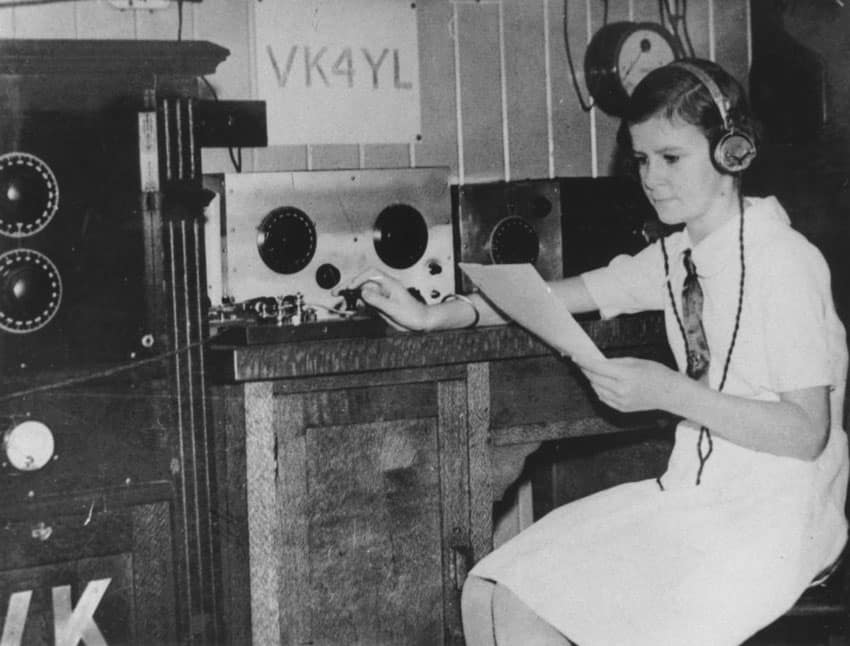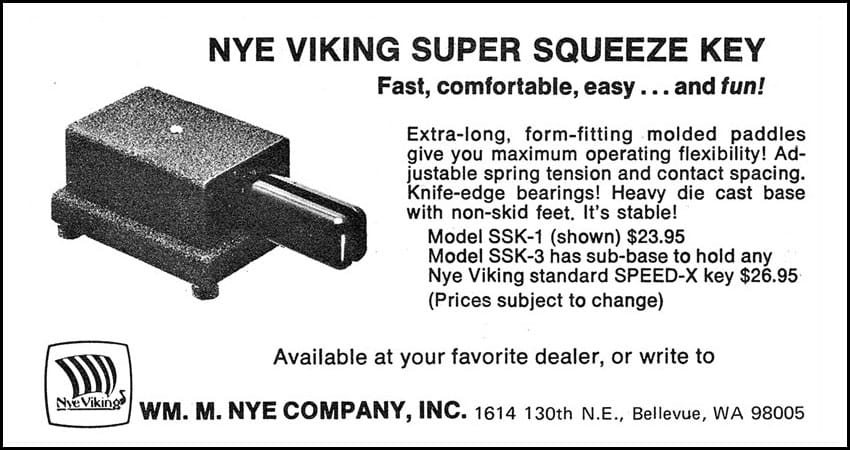This is a free fortnightly newsletter about the New Zealand Net.
If you would like to be notified by email when a new edition is published, please contact ZL1NZ.
Browse our Newsletter Archive and List of Net Tips.
Featured key

The John King combo paddle pictured above lets you choose between single-lever and dual-lever operation, all in the one key.
This key is just one of many models made by Janos (Jani) Kiraly HA8KN in Hungary.
Jani has another combo paddle, on a circular base, which allows the operator to easily remove the finger pieces they are not using. He also makes traditional single-lever and dual-lever magnetic paddles.
My general impression is that dual-lever paddles are now more popular than single-lever paddles – probably because they are essential when using the squeeze keying modes, such as Iambic A or B, or Ultimatic.
Dual-lever paddles can also be used without squeezing, but you do have to be careful not to squeeze accidentally. A single-lever paddle solves that problem, since squeezing is impossible.
So, the choice of paddle really depends on the choice of keying mode. But the combination paddles by Jani seem ideal for people who haven’t yet decided, or who like the challenge of switching their keying styles.
I find it interesting watching people doing squeeze keying in online videos. Some operators have truly mastered their chosen squeeze mode, with almost imperceptible hand movement, while others only squeeze on certain characters or parts of characters – which may be due to inherent weaknesses in the particular squeeze mode they are using which can make certain characters difficult to send by squeezing alone.
* If you have an interesting key for this feature, please send me a nice clear photo and a few words describing it.
Quick notes
 A few days ago, I heard someone refer to a certain type of straight key knob as a pacifier. That was a new one on me, but I knew right away what he meant! Am I the last person in the world to learn this term? I had only heard these vertical knobs with flat skirts or flanges described as Navy style.
A few days ago, I heard someone refer to a certain type of straight key knob as a pacifier. That was a new one on me, but I knew right away what he meant! Am I the last person in the world to learn this term? I had only heard these vertical knobs with flat skirts or flanges described as Navy style.
Many a straight key has been improved by adding a poker chip under the standard knob, and in the days of high keying voltages it was probably a useful safety feature too. Of course, they could have just replaced the knob with a pacifier. 🙂
VK2VMP is a new museum station aboard the destroyer HMAS Vampire at the Australian National Maritime Museum in Sydney. The amateur radio group is on the air Saturday afternoons, NZ time, and when I worked them last weekend they were S9 with 100W and a vertical (saltwater helps, no doubt). What’s especially nice about this station, is that they operate CW as well as SSB, so listen for them on 40 and 20m. VK2VMP will be participating in Museum Ships Weekend 0000Z 3 June to 2359Z 4 June.
This edition’s Featured Key might have got you thinking about the pros and cons of squeeze keying. If so, you’ll want to read the detailed analysis of squeeze keying later in this edition. Karl DJ5IL recounts the history of electronic keyers, and describes the keying mode that each engendered. Then he analyses squeeze keying modes in terms of their Stroke Rate, Hold Time and Persistence. And he has some stern words for how equipment manufacturers have sometimes misunderstood the keyers they built into their transceivers. This is an excellent article and it might even persuade you to try another keying mode!
CW Forever and Ever is a poem by Jim Hatherley WA1TBY (SK) published in the May/June Break-In magazine. Those who do not receive the magazine can read the poem online.
Photo flashback

The photo shows Madeline MacKenzie VK4YL at her home at Wynnum, Brisbane in 1934. She had passed her radio exams the year before, at age 12. Although she won several operating awards as a young amateur, Madeline did not reactivate her licence following World War II.
Review: T41 SDR transceiver

The T41 will no doubt be easier to use once all the controls are labelled. Photo: ZL2GVA
By Gerard ZL2GVA
Last week I was approached by Nev ZL2BNE to give his T41 a run on CW. The T41 is a Software Defined Radio kit designed by Jack Purdum W8TEE and Al Peter AC8GY. They have written a detailed book about the building and theory of SDR radios, which is very informative and goes deep into the signal processing that’s done by the software.
 At the heart of this radio is a Teensy 4.1 (hence the name T41) micro-processor doing the signal decoding and encoding. This means the radio is a fully stand-alone unit; it doesn’t need an external computer.
At the heart of this radio is a Teensy 4.1 (hence the name T41) micro-processor doing the signal decoding and encoding. This means the radio is a fully stand-alone unit; it doesn’t need an external computer.
The Teensy does all this running at 600 MHz, a bit faster than the 16 MHz of the Arduino Nano often used as a radio controller.
Nev built the radio and got it going well on phone, but he wanted to see how it behaved on CW. As this project, software and hardware, is designed as a developers platform, there are still some rough edges that can be improved.
One of the things we found was that we couldn’t change the internal keyer’s speed. Although a menu indicated it was set for 20 wpm, it kept running at something like 35 wpm! Then, when trying to use my external keyer, with the radio configured for a straight key, the receiver locked up.
Even using my Key-All, made to run older rigs with high voltage on the keying line though an optocoupler, didn’t fix the issue. So in the end it was back to my straight key, and I used this to check into the NZ Net on Monday 8 May.
The rig puts out up to 20 W. I ran it on 10 W, getting an S9 report. I’ve found that for 80m contacts within NZ, there’s not much practical difference between 10W and 100 W, so this report was as expected.
While playing around, I managed to get the radio in a sort of RIT mode that I couldn’t get out of. In the end the general good old computer problem fixer of a reset did the trick to get back to normal operation!
Neville extended the homebrewing on this project to 3D printing a colourful case for the radio as well, as you can see in the photo.
All in all this is an impressive unit, with amazing technology that’s now available to the homebuilder at a reasonable cost, however there’s still a bit of work needed on some of the practical aspects.
Net numbers

We had 139 check-ins to the Net during April, from 14 stations.
Here is the April net report as transmitted 1 May on the net:
NR30 R ZL1NZ 37/34 AUCKLAND 0900Z 1MAY23 = NZ NET = APR QNI VK3DRQ 18 VK4PN 3 ZL1AJY 2 ZL1ANY 19 ZL1AYN 1 ZL1NZ 20 ZL1PX 13 ZL2GD 4 ZL2GVA 14 ZL2KE 9 ZL2LN 5 ZL2TE 7 ZL2WT 9 ZL4KX 15 TOTAL 139 QTC 24 = ZL1NZ
Electronic keyers and squeeze keying
 By Karl DJ5IL
By Karl DJ5IL
In 2015 I asked an international group of dedicated and proficient amateur radio telegraphy operators for their preferred electronic keying mode and received 68 answers. Here is the result of my survey:
Iambic B – 36.8%
El-Bug – 30.9%
Iambic A – 20.6%
Plain Iambic – 10.3%
Ultimatic – 1.5%
Interestingly, the most effective squeeze-keying mode (Ultimatic) is by far the least common, while most operators prefer the least effective squeeze-keying mode (Iambic Type B) despite its problematic dot/dash memory logic.
And it turned out that the preference of most of them is not the result of an experimenting process with a final decision for the most effective and personally most suitable mode, but it is simply the mode they initially learned and then never changed. Once a certain keying mode is ingrained, it seems really hard to give it up for a better one.
Morse challenge
On 31 December 1997 the following message was transmitted from a coast radio station in southwest Scotland.
Your challenge is to tell me:
- the name and callsign of the radio station
- the question to which all R/Os “ken the answer”?
Please send your answers via radiogram to ZL1NZ, or via email if no propagation.
Answer to previous Morse challenge
The special character in Aria’s birthday card to ZL2KE was CM. It’s not on the official ITU list, but it is known to many CW operators. So what is it?
It is the exclamation point!
Correct answers were received from VK3DRQ and ZL2GVA.
Video: Distraction in the shack
By Stephen ZL3ABX
I’m doing a lot of listening as I try to become better at Morse. One day recently I tuned to the 20 metre band on a nearby online Kiwi SDRr receiver. I heard repeated CQ calls from VK2VMP and because the speed of the call was almost down to my ‘comfortable’ range, I tuned my small Xiegu transceiver and replied. I got no response using 15 watts, so I hastily switched the antenna and the power to the larger Yaesu and replied with about 80 watts. I got an answer and had a short QSO.
Although my confidence is building and I’m not so shy about going on air, this particular QSO was a challenge. I’d left the SDR station running on my computer and I was hearing both my call and VK2VMP’s reply as an echo!
We’d also just bought a new desk lamp for the office which is turned on and off by touching the metal body, and the danged thing decided it wanted to dance to my Morse. I’ve attached a short video demonstrating this phenomenon.
Editor’s comment: Light bulbs as RF indicators are a time-honoured feature of high power transmitter sites such as broadcast and communication stations. Himatangi Radio, for example, had flourescent light tubes installed high on the walls near the aerial feed-throughs and they would illuminate in synch with the radiotelegraph signals being transmitted – even though they were not wired to anything.
As for touch-lamps, I have found them to be not just erratic (as in Stephen’s video) but also good emitters of RFI (some of them at least) so I banished them from our home!
Advertising archive

QST, June 1976
Suggestions?
If you have suggestions on how to make the NZ Net better, or things you’d like to see covered in these updates, please contact ZL1NZ. You might even like to write something for the newsletter.
Thanks for reading, and I hope to hear you soon on the NZ Net!
—
Neil Sanderson ZL1NZ, Net Manager
New Zealand Net (NZ NET)
3535.0 kHz at 9pm NZT Mon-Fri


